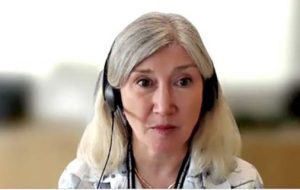GUELPH – Businesses in Wellington, Dufferin and Guelph are being instructed to have employees and others, such as contract workers, work from home beginning Dec. 20.
Wellington-Dufferin-Guelph Public Health (WDGPH) Medical Officer of Health Dr. Nicola Mercer issued a Dec. 16 letter instructing businesses and organizations to “ensure” employees conduct their work remotely “unless the nature of their work requires them to be on-site at the workplace.”
Mercer issued the instruction under Ontario’s Reopening Ontario Act and the Emergency Management and Civil Protection Act, which require employers to follow public health directions.

DR. NICOLA MERCER (Advertiser file photo)
“In response to persistently high and growing COVID-19 case counts in our region, I issue these instructions with continued support from Ontario’s chief medical officer of health, Dr. Kieran Moore,” Mercer stated, addressing rising cases of the new Omicron variant locally.
It’s not the first time a letter of instruction has been used in the health region.
In September, a letter of instruction was issued requiring volunteers, coaches, instructors and other sport officials to be vaccinated to enter a recreation facility and participate in organized sports.
Letters of instruction are a newer tool made possible by the province’s Reopening Ontario Act, allowing medical officers of health to issue instructions to businesses and organizations above and beyond what provincial legislation provides for, explained Associate Medical Officer of Health Dr. Matthew Tenenbaum, who was involved in making the decision with Mercer to issue the letter.
Medical officers of health can also issue Section 22 orders under the Health Promotion and Protections Act, but those orders require a higher bar to be met for justification than a letter of instruction does.
Tenenbaum said the health unit opted for a letter of instruction for that reason.
“It poses a lower obstacle to action on the part of the health unit,” Tenenbaum explained. “It’s a more logical tool to use for these kinds of instructions.”
Tenenbaum continued, “A letter of instruction really helps to emphasize the importance of this and the fact that this is not really optional; it actually is a pretty critical thing for businesses to be doing right now.
“One of the key things is for people not to be interacting in-person at work.”
According to a Public Health Ontario document titled Early Dynamics of Omicron in Ontario, it’s suggested each case of Omicron infects 7.7 times as many people as the Delta variant, considering data between Nov. 1 and Dec. 9.
Cases of COVID-19 shot up across the region this past weekend, with 299 newly confirmed cases reported by WDGPH on Dec. 20, more than doubling the number of active cases in the region, with 536 active cases as of Dec. 20.
The health unit has previously recommended remote work where possible but has shifted its tone in light of Omicron’s spread.
In previous waves, Tenenbaum said the health unit had to address “significant workplace outbreaks” and is still seeing transmission within workplaces despite recommendations and best practises to prevent transmission.
Tenenbaum said the letter shouldn’t be interpreted as, “‘I have to be here because my boss says I have to be here’ – that isn’t really the threshold.”
He explained there would need to be clear justification for having an employee not working remotely, such as a truck driver needing to be at work to drive a truck.
“But for example, if your job is to go into an office, and you’re at a computer, and you’re in meetings, like those are things that can be done virtually … those are the kinds of things that really should be done from home,” Tenenbaum said.
“It’s pretty common sense.”
For settings where workers cannot work remotely, employers are advised to provide virtual options for meetings, to ensure physical distancing in lunch rooms and to stagger lunches and breaks.
Mercer’s instruction doesn’t apply to governments or other agencies or organizations which support government operations and services, including those in health care.
Tenenbaum said the medical officers don’t have a timeline for how long the letter of instruction will be in effect for and said there would need to be a stable trend of improvement over a matter of weeks, including immunization rates and vaccine effectiveness before they would consider ending the instruction.
“Right now the situation is severe and concerning enough,” he said.
In Mercer’s Dec. 16 letter, she said, “These instructions will be enforced by public health officials and by provincial offences officers.”
Failure to comply could result in hefty fines for corporations of up to $10,000,000 at the extreme end and $500,000 for officers or directors of a corporation.
“I may amend these instructions … and will rescind them as soon [as] I determine they are no longer necessary,” Mercer stated in the letter.
To view the letter of instruction, visit wdgpublichealth.ca.




